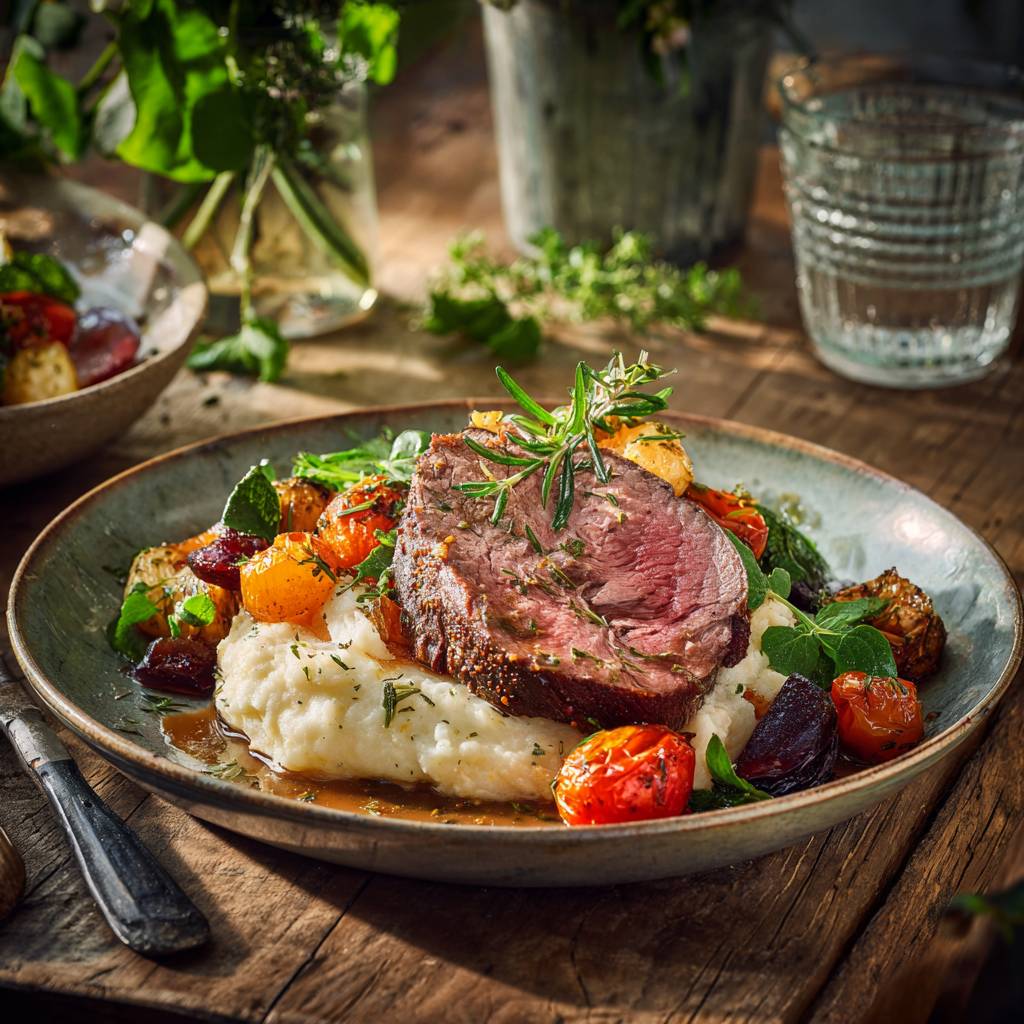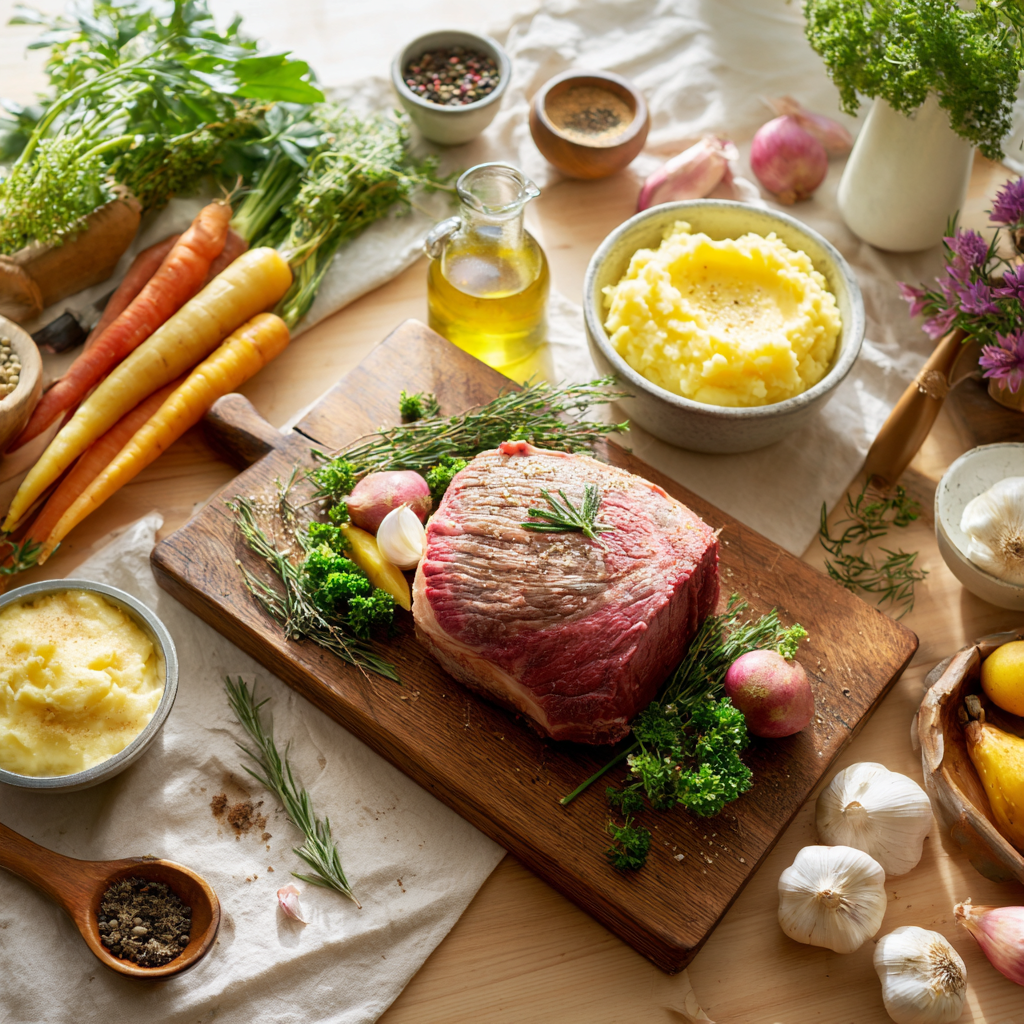
Why I Love Adding Roast Beef to My AIP Diet
I still remember the first time I tried the Autoimmune Protocol (AIP) diet. It felt overwhelming, like learning a new language. But over time, I found joy in discovering foods that made me feel good again. One of my favorite meals? Roast beef. There’s something comforting about its rich flavor and how easy it is to adapt for an autoimmune protocol roast beef recipe. It’s hearty, satisfying, and fits perfectly into my meal plan.
If you’re wondering, “Can you have roast beef on an AIP diet?”—the answer is yes. With a few tweaks, this classic dish becomes a safe and delicious choice. In this article, I’ll guide you step-by-step through making tender, flavorful roast beef while addressing common questions. You’ll learn how to pick the right cut, season it without inflammatory ingredients, and cook it until it’s fall-apart tender. Let’s get started!
What is the Autoimmune Protocol Diet?
The Autoimmune Protocol (AIP) diet isn’t just another trendy eating plan. It’s a way to calm your immune system by cutting out foods that cause inflammation. Think of it as hitting the reset button for your body. The goal is simple: remove triggers like grains, dairy, nightshades, and processed foods, then focus on nutrient-rich options that support healing.
At first, I wasn’t sure what to eat. But soon, I realized how many tasty choices were still available. For example, lean proteins like beef are allowed if prepared correctly. This brings us to why recipes matter so much on AIP. Without variety, sticking to the diet can feel boring. That’s where an autoimmune protocol roast beef recipe comes in handy—it keeps things exciting while staying compliant.
Can You Have Roast Beef on an AIP Diet?
Yes, you absolutely can enjoy roast beef on an AIP diet—but not all cuts or preparations work. Choosing wisely makes all the difference. Here’s what you need to know:
- Pick the right cut: Look for grass-fed beef with plenty of connective tissue, like chuck roast or brisket. These cuts become tender when cooked slowly.
- Season carefully: Stick to AIP-friendly spices such as garlic powder, onion powder, sea salt, and fresh herbs. Avoid anything processed or containing seed oils.
- Cook low and slow: Slow cooking breaks down tough fibers, giving you melt-in-your-mouth results every time.
One mistake people often make is rushing the process. High heat might seem quicker, but it leads to tough meat. Instead, patience pays off. When done right, even cheaper cuts transform into juicy, flavorful meals.
How to Make Roast Beef Fall Apart Tender
There’s nothing worse than biting into dry, chewy roast beef. Luckily, avoiding this is easier than you think. Follow these tips to nail the texture every time:
- Start with moisture: Use beef broth or bone broth during cooking to keep the meat hydrated. I like adding a splash of apple cider vinegar for extra tenderness.
- Don’t skip searing: Browning the outside locks in juices and adds depth to the flavor profile. Just use avocado oil or another AIP-safe fat.
- Keep it covered: Whether you’re using a slow cooker, Instant Pot, or oven, covering the roast traps steam and ensures even cooking.
- Let it rest: After cooking, give the roast at least 10 minutes before slicing. This allows juices to redistribute throughout the meat.
For those wondering, “What is the best cooking method for a beef roast with a lot of connective tissue?” slow-cooking wins hands down. Connective tissue needs time to break down, which happens naturally at lower temperatures. Trust me, the wait is worth it!
Why This Recipe Works for AIP
This autoimmune protocol roast beef recipe checks all the boxes: it’s free from inflammatory ingredients, packed with nutrients, and downright delicious. Plus, leftovers store well, making meal prep a breeze. I love slicing it thin for salads or serving it alongside roasted veggies. It’s versatile enough to fit into any day of the week.
Here’s a quick summary of why this dish shines:
- It uses whole, unprocessed ingredients.
- It’s rich in protein and essential nutrients.
- It satisfies cravings without compromising your health goals.
Ready to try it yourself? Keep reading for the full step-by-step instructions. By the end, you’ll have a foolproof plan for creating restaurant-quality roast beef that fits seamlessly into your AIP lifestyle.
Choosing the Right Cut of Beef
Let’s talk about cuts for a sec. Not all beef is created equal, especially when you’re aiming for that melt-in-your-mouth texture. Funny enough, I used to think the fancier the cut, the better the roast. But boy, was I wrong! Lean cuts like sirloin or tenderloin might sound impressive, but they lack the connective tissue needed to make slow-cooked meals truly shine. Instead, I’ve fallen in love with tougher, more humble cuts like chuck roast or brisket. These are the unsung heroes of the beef world.
Here’s why: connective tissue is packed with collagen, which breaks down into gelatin during slow cooking. This process not only makes the meat ridiculously tender but also adds a depth of flavor you just can’t get from lean cuts. It’s kind of like turning a rough-around-the-edges character into the hero of the story. By the way, if you’re wondering “What is the best cooking method for a beef roast with a lot of connective tissue?”—spoiler alert—it’s slow roasting. Low and slow is the name of the game here.
When shopping, look for grass-fed options whenever possible. They’re not only better for your health but also have a richer taste. And hey, if you’re meal prepping for the week, these cuts are budget-friendly too. You can stretch them further by pairing them with some hearty autoimmune protocol soup recipes. Talk about a win-win!
How to Avoid Tough Roast Beef
Nobody wants to bite into a piece of roast beef that feels like chewing on an old shoe. Ugh, right? The good news is, avoiding tough meat isn’t rocket science—it just takes a little know-how. Here’s what I’ve learned through trial (and plenty of error).
First up, temperature control is key. Cooking at too high a heat will cause the muscle fibers to seize up, leaving you with something closer to jerky than roast. Keep it low—around 275°F in the oven or on the “low” setting if you’re using a slow cooker. Patience is your best friend here.
Seasoning plays a role too. Sure, spices add flavor, but overdoing it with certain ingredients can dry out the meat. Stick to AIP-friendly seasonings like fresh rosemary, thyme, or a dash of sea salt. Oh, and don’t forget to rub those seasonings into the meat before cooking. It helps create a barrier that locks in moisture.
Another pro tip? Don’t overcook it. I know, I know—you want to be sure it’s done. But trust me, there’s a fine line between perfectly cooked and “oops, now it’s dry.” If you’re unsure, invest in a meat thermometer. For beef, aim for an internal temp of about 195°F to 205°F. That’s usually where the magic happens.
By the way, speaking of magic, did you know that pairing your roast beef with brunch dishes can elevate your weekend spread? Check out some make ahead brunch recipes Ina Garten style for inspiration. Imagine slicing up your roast beef thin and serving it alongside her cheesy strata. Game changer!
Alright, so we’ve covered how to avoid tough meat—but how do you take it to the next level? Let me tell you, making roast beef fall-apart tender is easier than you think.
Making Roast Beef Fall-Apart Tender
I’ll admit, I didn’t always nail the perfect roast beef. There were times when I ended up with something more akin to shoe leather than dinner. But after years of experimenting—and a few epic fails—I finally cracked the code. Here’s how you can achieve that melt-in-your-mouth texture every single time.
Start by searing the meat. Now, I know I mentioned this earlier, but let me emphasize: DO NOT SKIP THIS STEP. Searing creates a caramelized crust that adds layers of flavor. Use avocado oil or ghee since they’re both AIP-compliant and can handle high heat without burning. Pop the meat into a hot skillet for a couple of minutes per side until it’s golden brown all over.
Next, transfer the seared roast to your slow cooker or Dutch oven. Add liquid—beef broth works wonders, but toss in some apple cider vinegar or lemon juice for extra tenderness. Cover it tightly, whether with a lid or aluminum foil, and let it cook undisturbed. If you’re using an oven, set it to 275°F; if you’re using a slow cooker, go for “low” mode. Either way, give it at least 6 hours. Yes, patience is still required!
Here’s a fun fact: braising is another technique worth trying. It combines searing with moist heat, much like what we’ve already discussed. My favorite tool for this? A trusty crockpot. Just throw everything in, press start, and walk away. It’s almost too easy. If you’re looking for variety in your meal prep, consider whipping up a Bobby Flay brunch casserole recipe to serve alongside your roast beef later in the week.
Oh, and one last thing—let the roast rest before slicing. I learned this the hard way after hacking into a roast straight out of the oven, only to watch all the juices spill onto the cutting board. Lesson learned: give it at least 10 minutes to cool slightly. This lets the juices redistribute throughout the meat, ensuring each slice is as juicy as the last.
Speaking of slices, ever tried pairing your roast beef with a breakfast classic? Give Ina Garten’s breakfast strata recipe a shot. Picture this: tender roast beef layered with creamy eggs and crispy bread. Pure bliss.
Look, mastering the art of fall-apart tender roast beef might take a few tries, but once you get it, you’ll feel like a culinary wizard. Trust me, your taste buds—and your body—will thank you.
Step-by-Step Autoimmune Protocol Roast Beef Recipe
Alright, let’s dive into the good stuff—the recipe itself. I’ll walk you through it step by step so you can nail this autoimmune protocol roast beef recipe on your first try. Trust me, once you get the hang of it, you’ll want to make this a staple in your meal rotation.
Ingredients:
- 3–4 lb grass-fed chuck roast or brisket
- 2 tbsp avocado oil (or ghee)
- 1 cup AIP-compliant beef broth
- 2 tbsp apple cider vinegar
- 1 tsp sea salt
- 1 tsp garlic powder
- 1 tsp onion powder
- Fresh rosemary and thyme sprigs (optional but recommended)
Instructions:
- Prep the meat: Pat the roast dry with paper towels. This helps it sear better. Sprinkle both sides generously with sea salt, garlic powder, and onion powder. Rub the spices into the meat for an even coating.
- Sear it up: Heat the avocado oil in a large skillet over medium-high heat. Once hot, add the roast and sear each side for about 2–3 minutes until golden brown. You’re not cooking it all the way through here—just creating that flavor-packed crust.
- Transfer to your cooking vessel: Place the seared roast in a slow cooker, Dutch oven, or baking dish. If using a Dutch oven or baking dish, preheat your oven to 275°F while you prep the next steps.
- Add liquid and aromatics: Pour in the beef broth and apple cider vinegar. Toss in the fresh rosemary and thyme sprigs if you’re using them. The acid from the vinegar will help tenderize the meat even more.
- Cover and cook: For a slow cooker, set it to “low” and let it go for 8–10 hours. If you’re using a Dutch oven or baking dish, cover tightly with aluminum foil or a lid and pop it in the oven for 6–8 hours. Check periodically to make sure there’s enough liquid; add more broth if needed.
- Rest and slice: Once the roast is fork-tender, remove it from the heat and let it rest for at least 10 minutes. Slice it against the grain for maximum tenderness, or shred it with two forks if you prefer pulled beef.
And there you have it—a foolproof autoimmune protocol roast beef recipe that’s as comforting as it is compliant. Pair it with some roasted sweet potatoes or steamed broccoli for a complete meal. Oh, and don’t forget to save those juices! They make an incredible gravy alternative when thickened with a bit of arrowroot powder.
Picking Perfect Side Dishes
Funny enough, I used to think side dishes were just an afterthought. But pairing your roast beef with the right sides can take the whole meal to another level. Here are some ideas that work beautifully within the AIP framework:
- Mashed cauliflower: Creamy, comforting, and packed with nutrients—it’s like mashed potatoes without the inflammation.
- Roasted root veggies: Think carrots, parsnips, and turnips tossed in olive oil and herbs. They caramelize beautifully in the oven.
- Green beans almondine: Sautéed green beans with slivered almonds add crunch and freshness to balance the richness of the beef.
- Simple salad: A mix of leafy greens, cucumber, and avocado dressed with lemon juice and olive oil keeps things light yet satisfying.
Here’s the thing: these sides aren’t just tasty—they’re also incredibly easy to throw together. And hey, if you’re looking for something a little different, why not check out some AIP breakfast recipes? Believe it or not, certain brunch staples like savory frittatas or veggie-packed hash can double as dinner sides too.
Why This Recipe Is Worth It
Let’s be real—cooking for the AIP diet can sometimes feel restrictive. But this autoimmune protocol roast beef recipe proves that healthy eating doesn’t mean sacrificing flavor or satisfaction. There’s something deeply rewarding about transforming humble ingredients into a dish that feels indulgent yet nourishing. Plus, knowing you’re fueling your body with nutrient-dense food makes every bite taste even better.
By the way, one of my favorite memories involving this recipe happened last winter. My family was over, and I served this roast beef alongside roasted Brussels sprouts and mashed cauliflower. Everyone raved about how flavorful it was—and no one guessed it was AIP-compliant. That moment reminded me that food isn’t just about following rules; it’s about connection and joy.
So go ahead, give this recipe a shot. Whether you’re cooking for yourself or sharing it with loved ones, I promise it’ll bring a little extra warmth to your table.
Frequently Asked Questions (FAQ)
Can you have roast beef on an AIP diet?
Absolutely! Roast beef is allowed on the AIP diet as long as you choose the right cut and prepare it with compliant seasonings. Grass-fed beef is ideal, and stick to AIP-friendly spices like garlic powder and fresh herbs.
What is the best cooking method for a beef roast with a lot of connective tissue?
Slow cooking is hands down the best method. Low and slow heat breaks down the collagen in connective tissue, resulting in tender, juicy meat. Use a slow cooker, Dutch oven, or oven set to 275°F.
How to avoid tough roast beef?
To prevent toughness, cook at low temperatures and avoid overcooking. Searing the meat before slow-cooking locks in moisture, and letting it rest afterward ensures juiciness.
How to make roast beef fall apart tender?
Sear the meat first, then braise it in liquid for several hours. Adding acidic ingredients like apple cider vinegar helps break down fibers, making the meat incredibly tender.
Is it okay to use store-bought beef broth?
Yes, but read the label carefully. Many broths contain additives that aren’t AIP-compliant. Opt for homemade or certified AIP-friendly brands.
Can I freeze leftover roast beef?
Definitely! Store leftovers in an airtight container or freezer bag for up to three months. Reheat gently in a saucepan with a splash of broth to keep it moist.
What spices should I avoid on AIP?
Stay away from nightshades like paprika, cayenne, and chili powder. Also skip seed-based spices such as cumin and coriander.
How do I thicken the cooking juices?
Whisk in a slurry of arrowroot powder and water, then simmer until thickened. Avoid flour or cornstarch, which aren’t AIP-compliant.
Can I use a pressure cooker instead of slow cooking?
Yes, an Instant Pot works great. Cook on high pressure for about 90 minutes, then let the pressure release naturally.
What vegetables pair well with roast beef?
Root vegetables like carrots and parsnips are excellent choices. Leafy greens and cruciferous veggies like broccoli also complement the rich flavors nicely.
Final Thoughts
There’s nothing quite like sitting down to a meal that’s both delicious and healing. With this autoimmune protocol roast beef recipe, you’re not just feeding your body—you’re celebrating it. So roll up your sleeves, grab your favorite grass-fed cut, and get cooking. Your taste buds (and your immune system) will thank you.
Oh, and one last thing: don’t keep this gem to yourself. Share your experience in the comments below—I’d love to hear how it turned out for you!

Autoimmune Protocol Roast Beef Recipe
Ingredients
Equipment
Method
- Pat the roast dry with paper towels and season with sea salt, garlic powder, and onion powder, rubbing the spices into the meat.
- Heat avocado oil in a large skillet over medium-high heat and sear the roast on each side for 2–3 minutes until golden brown.
- Transfer the seared roast to a slow cooker, Dutch oven, or baking dish. Preheat oven to 275°F if using.
- Pour in the beef broth and apple cider vinegar. Add fresh rosemary and thyme if desired.
- Cover and cook on low in a slow cooker for 8–10 hours or in the oven for 6–8 hours, checking liquid levels periodically.
- Once the roast is fork-tender, remove it from heat and let it rest for at least 10 minutes before slicing against the grain.


